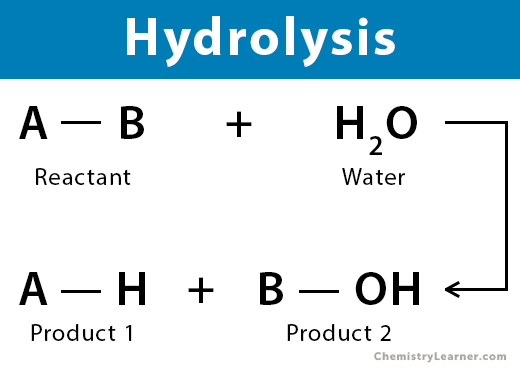Describe the Role of Water in a Hydrolysis Reaction
Since it involves the addition of water this explains why it is called hydrolysis meaning splitting by water. In biotechnology and as far as living organisms are concerned these substances are often polymers simply put.

Hydrolysis Reaction Of Vegetable Oil Download Scientific Diagram
The first commercial application of hydrolysis was in the making of soap.

. Using water molecules complex molecules are broken down into smaller units. In these reactions polymers are broken apart by adding a water molecule and separating the polymer back into. In this process a hydrogen ion H is added to one component and a hydroxide ion OH- is added to another one.
Therefore it is the opposite of the dehydration synthesis reaction. In other words hydrolysis is a chemical reaction which splits a molecule into smaller units by the addition of water molecules. Hence hydrolysis is the chemical breakdown of a substance using water.
A large molecule is split into smaller sections by breaking a bond adding -H to one section and -OH to the other. The products are simpler substances. In chemistry acid hydrolysis is a process in which a protic acid is used to catalyze the cleavage of a chemical bond via a nucleophile substitution reaction with the addition of the elements of water H 2 O.
Dehydration synthesis o Occurs during the synthesis of biomolecules o One subunit looses an -H o Other subunit loses an -OH o New. Describe the role of water in hydrolysis and dehydration synthesis. Hydrolysis can be considered as the reverse reaction of a dehydration synthesis reaction.
Although such reactions are clearly feasible in aqueous solution the applicability of this mechanism to the gas phase must be additionally proved on the basis of available experimental data on the direct gas-phase kinetic measurements. It involves the addition of water molecule with cleavage of bonds to form more than one substance from one substance. Hydrolysis Examples.
Occurs during the synthesis of biomolecules ii. What elements are found in carbohydrates lipids proteins and nucleic acids. Mention a specific hydrolysis reaction in your answer.
Water is an essential reactant molecule in hydrolysis reactions. Large molecules are broken down by breaking the bond between water molecules. Hydrogen evolution reaction HER and oxygen evolution reaction OER.
Hydrolysis is simply using water to break a bond. Hydrolysis is the opposite to condensation. Hydrolysis is a reaction with water.
How are carbohydrates formed hydrolysis. Distinguish between a dehydration reaction and a hydrolysis reaction. Reaction in which water reacts with a compound to produce other compounds What happens during a hydrolysis reaction.
It helps the small intestine to absorb nutrients more effectively. Dehydration synthesis condensation i. A common type of hydrolysis occurs when a salt of a weak acid or.
Acid hydrolysis of disaccharides and polysaccharides produces monosaccharides by breaking the glycosidic links ether bonds between monomer units in the structure of the molecule. Describe the role of water in both dehydration and hydrolysis reactions in altering biological macromolecules. Hydrolysis is a process where a water molecule is added to a system but dehydration synthesis is a process where a water molecule is removed from a system.
Speight in Reaction Mechanisms in Environmental Engineering 2018 31 Acid Hydrolysis. 27 Describe the role of water in both dehydration and hydrolysis reactions in altering biomolecules. Ester Hydrolysis Reaction If we take the same example as in dehydration synthesis reaction hydrolysis of an ester forms the reactants of esterification reaction.
Hydrolysis which is the reverse of a dehydration reaction works the same way. During hydrolysis a macromolecule is broken down into simpler units. Identify a carbohydrate by its chemical formula.
Relative to the process of dehydration synthesis hydrolysis is merely the reverse. HER is the reaction where water is reduced at the cathode to produce H 2 and OER is the reaction where water is oxidized at the anode to produce O 2. A chemical reaction using water to separate molecules.
Hydrolysis separates molecules into parts mostly and dehydration synthesis condenses molecules into a larger molecule. The saponification reaction occurs when a triglyceride fat is hydrolyzed with water and a base usually sodium hydroxide NaOH or potassium hydroxide KOH. Hydrolysis reaction at low temperature is the coordination of additional water molecules to the transition structures.
Hydrolysis Key Terms Hydrolysis. Fatty acids react with the base to produce glycerol and salts which becomes soap. Describe the role of water in a hydrolysis reaction.
Describe the role of water in condensation and hydrolysis reactions. The reactant of hydrolysis is a complex molecule whereas products of hydrolysis are small molecules or fragments. This is because in condensation reactions a water molecule is formed whereas in hydrolysis a water molecule is consumed.
Generally the overall reaction of water electrolysis can be divided into two half-cell reactions. Water molecule provides a hydroxyl group -OH and a proton -H group for the products. In its simplest definition hydrolysis is a chemical reaction in which water is used to break down the bonds of a particular substance.
Hydro- stands for water while -lysis stands for the breaking down of molecules. Write the reversible reactions with its corresponding enzymes of Dehydration via Hydrolysis reaction. Splits one chemical bond the addition of the proton and the hydroxide anion form the water.
For each type of organic molecule be able to describe general structure and function and give an example of each. New covalent bond formed and water produced. Acid and base hydrolysis involve the use of water as a catalyst to drive the hydrolysis reaction.

Hydrolysis Definition Reaction Equation Example Study Com


Comments
Post a Comment